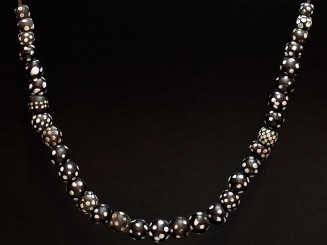33 Venetian trade beads (B&W Skunk)
Mauritania
Lenght: 33 cm
Weight: 61 gr
Units: 33
The model of these thirty-three beautiful Venetian trade beads is without any doubt among those most popular in barter trade in West Africa. They were made at artisan workshops in Venice from the mid-1800s to the first third of the 19th century using the lamp work technique. The very typical eye or dotted decoration classes them as eye beads. The combination of white dots on a black background, though there are other combination of colors, made them known in the trade as “black and white skunk” as they reminded of the fur of this animal. In Spain they where also known as “Moorish” beads and where sometimes found as part of the jewellery arrangements of traditional “charra” jewellery from the province of Salamanca.
The larger bead measures approximately 12mm (long) and 14 mm (diameter).
We use the term trade beads to refer to the European made glass beads that were used by the European merchants and explorers in the trade in Africa as from the 15th century and continued during their colonial expansion. The history of trade beads in Africa takes us then to the 15th century and the arrival of the European, mainly the Portuguese, to the coasts of West Africa. The European discovered quite soon how much the people they met there fancied beads and saw they an opportunity for trade. Amongst the beads that captivated the African people most were glass beads since the techniques for their making had not yet been developed locally. The locals fell for the precious and colorful glass beads such as Venetian millefiori or chevron beads that the European traders had on offer and bartered them for commodities such as precious woods, ivory, gold and even used, ignominiously, in the slave trade. The increasing demand in Africa of European made glass beads continued quite until the first half of the 20th century and it had a boosting effect in the production in cities such as Venice which glass beads became very popular and coveted.
Eye glass beads are beads which main feature are circular decorations that remind of an eye made using lamp work, inset or mosaic techniques. One of the best examples of eye beads are found among Islamic beads mostly blue or green with white eyes as well as eye dotted Venetian glass beads (skunk). The eye decoration may be a simple eye or a number of them scattered on the surface of the bead, they may be plain ones or concentric ones using different colors. Eye beads may also present some linear trails, ziz-zag or floral decoration. Eye beads have been very much valued for centuries, actually they still are, among not only Islamic people but also African people as they were regarded as strong amulets to avert the evil eye and for their alleged prophylactic and magical properties.
Lamp working is one of the main techniques for the making of glass beads. Lamp or lamp work beads were made using glass canes that were reheated to a temperature of up to 1000 ºC by means of a blowtorch or blowlamp and which were then wound onto a coated iron rod to avoid the molten glass from sticking to the metal. The beads produced by the artisan by these means could be then further decorated by re-heating the bead using the same lamp work method and applying colored glass rods or glass cane inserts to the surface of the bead creating an endless variation of patterns and making of each bead one of its own.



